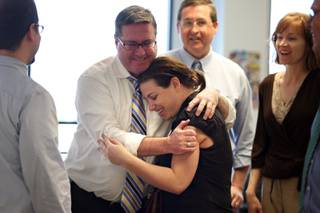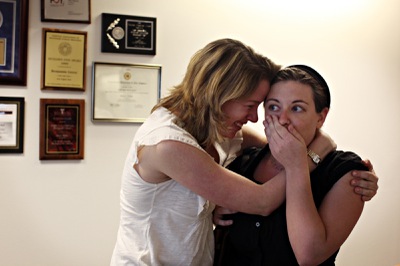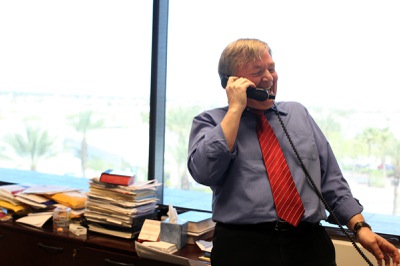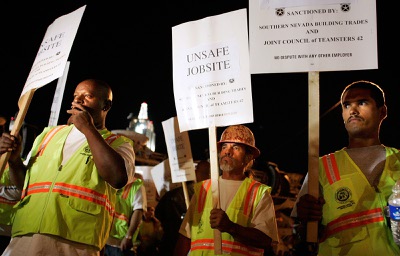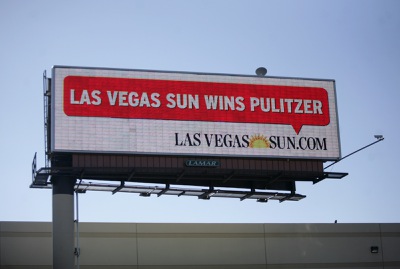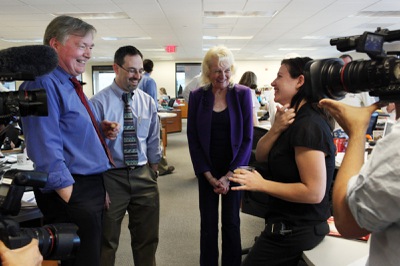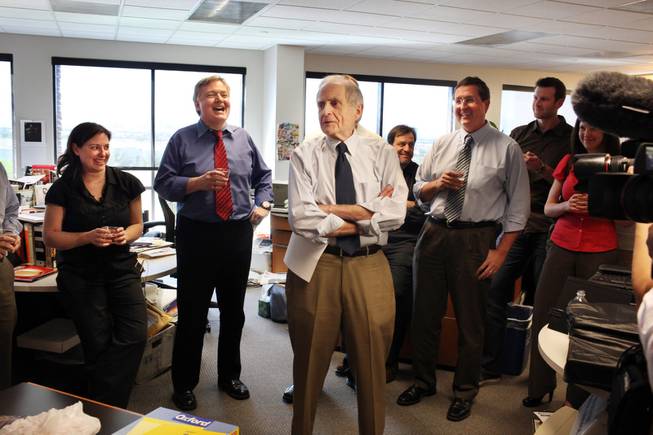
Reporter Alexandra Berzon, from left, Deputy Managing Editor Drex Heikes and other Las Vegas Sun employees gather April 20 as Managing Editor Michael J. Kelley, center, talks about the paper’s winning the Pulitzer Prize for Public Service for stories about construction workers’ deaths on the Strip.
Tuesday, April 21, 2009 | 2 a.m.
Sun wins Pulitzer
The Las Vegas Sun on Monday won the Pulitzer Prize for Public Service, journalism's most prestigious award, for its investigation of construction deaths on the Las Vegas Strip and the failures of government, management and labor unions to protect workers. Judges singled out Sun staff writer Alexandra Berzon for "courageous reporting" in persevering against closed doors and intimidation.
Prestigious Honor
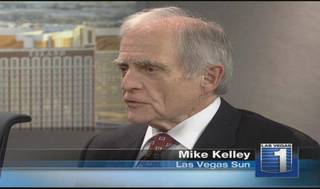
Viewing video requires the latest version of Adobe's Flash Player
Sun coverage
The Las Vegas Sun on Monday won the Pulitzer Prize for Public Service — journalism’s most prestigious award — for its investigation of construction deaths on the Las Vegas Strip and the failures of government, management and labor unions to protect workers.
Judges singled out Sun staff writer Alexandra Berzon for “courageous reporting” in persevering against closed doors and intimidation. Her reports, coupled with editorials written by David Clayton and Matt Hufman, led to congressional hearings and worker-safety reforms.
Berzon, 29, may have been the last Sun employee to learn of the award. When the prize was announced, Berzon was at a court hearing for a lawsuit about worker safety.
Efforts to call Berzon failed because she had lost her cell phone. When she walked into the newsroom 30 minutes later, she was greeted with a standing ovation from reporters and editors.
“You won the Pulitzer!”
“I don’t understand, for what?” Berzon said, stopping in her tracks.
“For Public Service!”
Sun archives
- Las Vegas Sun wins Pulitzer Prize (4-20-09)
Her mouth fell open before she covered her face with her hands.
Because the editors had received no inkling that the newspaper would receive the award, they had assumed the Sun had not won it. Deputy Managing Editor Drex Heikes, who edited Berzon’s stories, began checking the online news wires at noon for the list of winners.
“We just won a Pulitzer,” Heikes said to no one in particular, so incredulous that he sounded out of breath. His face flushed. “We just won a Pulitzer!” he yelled in a stronger voice.
Judges gave the Public Service award to “the Las Vegas Sun, and notably the courageous reporting by Alexandra Berzon, for the exposure of the high death rate among construction workers on the Las Vegas Strip amid lax enforcement of regulations, leading to changes in policy and improved safety conditions.”
Message from Sen. Harry Reid
The Pulitzer Prizes are sponsored by the Columbia School of Journalism in New York City.
The Sun’s Pulitzer victory is a win for the underdog — workers on the Strip, a young reporter and an all-enterprise newspaper that doesn’t cover the ordinary news of the day — and provides inspiration at a time when journalism is reeling from cutbacks.
Editor Brian Greenspun’s father, Hank, started the newspaper in 1950 and built a reputation for standing up against racial segregation on the Strip, the IRS and Sen. Joseph McCarthy. Brian Greenspun said the construction death series was a continuation of his father’s campaign to stand up for the working men and women “who didn’t have a voice.”
“This story was about the failure of government and an attitude of the people that said it was not important to inspect for safety violations the way they’re supposed to, which results in working people getting hurt,” Greenspun said. “It was a failure up and down the line ... When it gets fixed, that means you saved that many people’s lives. What greater purpose can you have in the newspaper business?”
Sun Managing Editor Michael J. Kelley said the Pulitzer is a credit to the journalists who wrote the stories and editorials and to Brian Greenspun and the entire Greenspun family.
“They have supported with their checkbooks, and with their enthusiasm, the Las Vegas Sun’s practice of in-depth, high-quality journalism for the people of Southern Nevada,” Kelley said.
When Berzon was interviewed for a job at the Sun in late 2007, Heikes mentioned that she might be assigned to look into what seemed to be an unusual number of construction deaths on the Strip. In early 2008, she was launched on the project, by which time nine construction workers had perished in 16 months. “We want to know what’s going on,” Heikes told Berzon.
This was Berzon’s first newspaper staff job. She had come to the Sun from a technology publication and before that the graduate journalism program at the University of California, Berkeley.
Berzon spent more than six weeks to prepare the first two stories in what would become a yearlong series of reports, slogging through the OSHA bureaucracy and ignoring threats of physical harm if she showed up at a union hall.
“I came to realize she had this combination of smarts and pugnaciousness,” Heikes said. “She does not take no for an answer.”
Before the Sun exposed the problems, construction safety had been a nonissue in Las Vegas. Worker deaths were considered the cost of doing business along the Strip, which was in the heat of a $32 billion building boom.
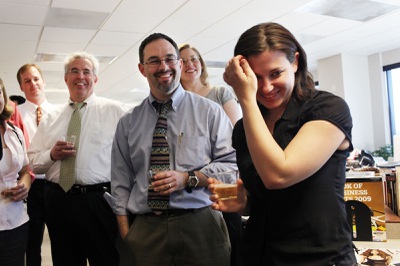
Editorial writers, David Clayton, from left, and Matt Hufman, share in remarks and champagne with reporter Alexandra Berzon on Monday in celebration of the Las Vegas Sun winning the Pulitzer Prize for public service for exposing a high death rate among construction workers on the Las Vegas Strip, at the Las Vegas Sun offices.
Berzon said there was a feeling at the time that there was so much construction happening so fast that “of course people were going to make mistakes and die.”
No one had questioned the status quo, and in a town that revolves around gaming, challenging the construction culture seemed bad for business. But Berzon plunged ahead, uncovering a system that had become corrupted by coziness among contractors, OSHA and the unions. She reported that:
• Twenty-four-hour construction schedules on highly congested work sites created unsafe conditions.
• Nevada OSHA investigated the accidents but withdrew or vastly reduced findings of violations after meeting privately with contractors. Contractors blamed the deaths on the workers.
• Federal OSHA had weakened safety requirements, removing protections that could have prevented some deaths.
• Nevada union officials failed to act as safety advocates for workers.
Still photography and video by the Sun’s new-media team accompanied the stories, further showing the emotional toll the deaths took on workers’ families. The Sun’s editorial page called for reforms.
By the end of 2008, what had begun as a two-part series ended up as 53 stories and 21 editorials.
CityCenter Workers Strike
Construction workers shut down MGM Mirage's CityCenter at midnight Monday, walking off the job to protest safety conditions at the $9.2 billion project. Workers also began picketing outside of CityCenter, holding signs that read, "unsafe job site."
Berzon said even laborers resisted cooperating with her for fear of jeopardizing their jobs and the construction projects. The turning point came June 3 when workers walked off the job at MGM Mirage’s $8.7 billion CityCenter. Workers carried picket signs, demanding safer conditions. She felt satisfaction: “This is really good for them. This can really make a difference.”
Berzon’s stories, and the editorials of Clayton and Hufman, resounded in Congress, where Senate and House committees referred to the Sun’s work in hearings on OSHA reform.
Most important, Kelley points out, the deaths stopped in June 2008 after 12 fatalities in 18 months. A culture shift that favors the safety of workers took place in the wake of the Sun’s work.
Kelley, whose first newspaper job was as a copy boy at the Kansas City Times in 1960, said it’s an unexpected thrill to win the Pulitzer, but the real purpose in journalism is putting out a quality product every day that improves the community.
“Winning the Pulitzer is fabulous but the fact that this series stopped people from dying on the Las Vegas Strip construction projects is the most important part of what we did,” he said.
The Pulitzer comes to a newspaper that offers a unique model of journalism in the United States, at a time when the industry is looking for answers to withering circulation, declining ad sales and corresponding layoffs. Typically the biggest prize in journalism goes to big publications with big reputations. Also nominated as finalists in the Public Service category were The New York Times for its coverage of the economic meltdown of 2008, and the St. Petersburg Times for “PolitiFact,” its fact-checking initiative during the 2008 presidential campaign.
The Sun has always been a scrappy paper, first publishing in the morning and then in the afternoon, when its circulation had dropped by 2005 to about 35,000. That year Brian Greenspun renegotiated the Sun’s joint operating agreement with its competitor, the Las Vegas Review-Journal, to embark on a pioneering experiment. The Sun ceased operating as an afternoon newspaper and started being delivered inside the morning Review-Journal, with which it still competes fiercely. That raised the circulation to about 180,000 daily, and boosted the Sun’s reach in Las Vegas.
With that transition, Kelley refocused the newspaper’s mission to concentrate on enterprise and investigative reporting. Kelley imagined a daily paper in the vein of magazines like The Economist, Time and Sports Illustrated. The print Sun’s relatively small staff probed the community in ways that had not been done before in Las Vegas. The breaking news that print newspapers traditionally covered was left to the competition until the Sun launched its award-winning Web site in 2008.
Greenspun said he was thinking “with an eye to what newspapers needed to be in the future.”
He said the Internet serves readers best by doing what newspapers did in past decades: car crashes, crime stories, house fires. The Sun’s Web site staff of reporters, videographers and editors provides breaking news updates throughout the day as well as multimedia features. Also on Monday the Sun’s Web site was named as a finalist in four categories for the EPpy awards, one of the most prestigious contests in online journalism.
But Greenspun said people still want and need in-depth stories, “the ones that tell the ‘why’ and the ‘how’ — that makes a city and community better.”
Kelley hired Heikes, for 18 years an editor at the Los Angeles Times, as well as other experienced editors from the L.A. Times, San Jose Mercury News, the San Francisco Chronicle and The Dallas Morning News. The editors spurred reporters to think outside the bounds of traditional newspaper reporting and provided time for probing projects each year. Berzon credits Heikes for coming up with the idea for the project and pressing her to relentlessly pursue the story.
Greenspun said that the Sun’s new structure gave Berzon the time and resources she needed to devote to the prizewinning story.
It’s possible the Sun could be a model for other newspapers, Greenspun said. They won’t need to go through the experimental phase, he said. They can just adapt.
“We may be closer to the model for what newspapers will look like in a few years,” he said.
